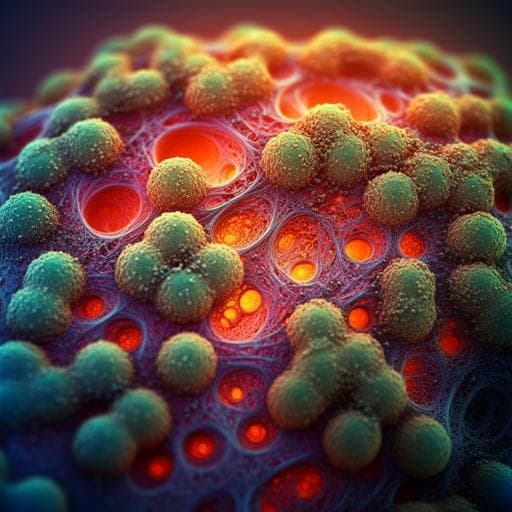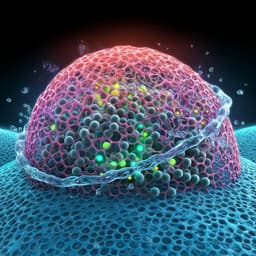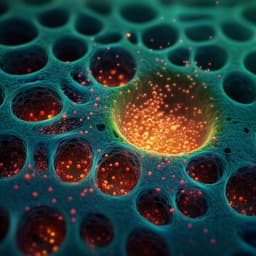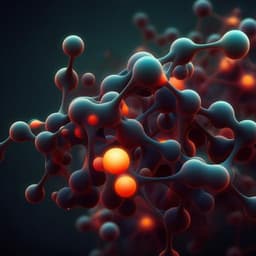
Environmental Studies and Forestry
Development of catalytic zero-valent iron incorporated PAN catalytic film for efficient degradation of organic matters
Y. Yang, H. Lin, et al.
This groundbreaking study introduces a highly effective nanoscale zero-valent iron (NZVI) incorporated porous PAN fiber film, demonstrating over 95% conversion for organic matter degradation in just 4 minutes. With its excellent stability and reusability, the Fe-PAN film showcases tremendous potential for industrial applications. This research was conducted by Yi Yang, Haowen Lin, Yuxi Long, Ying Mei, and J. Paul Chen.
~3 min • Beginner • English
Introduction
Organic contamination causes environmental problems, and conventional activated sludge performs poorly at low COD (<50 mg/L). Alternative treatments include adsorption, advanced oxidation processes (AOP), membrane filtration, and ion exchange. Heterogeneous catalytic wet peroxide oxidation (CWPO) is attractive for its simplicity and low cost. Nanoscale zero-valent iron (NZVI) offers low cost, environmental friendliness, and high efficiency but suffers from surface oxidation, difficult separation, efficiency loss, particle loss, and secondary pollution. Immobilizing NZVI on stable porous substrates can mitigate these issues. Polymeric fiber films provide corrosion resistance, mechanical strength, modifiability, ductility, and high voidage; π electrons in polymers enhance binding to iron via electrostatic/conjugated interactions, enabling synergistic improvements in activity and stability over inorganic supports. Electrospinning enables controllable polymer fiber films, but traditional integration of metals involves multistep processes (hydrothermal, redox, calcination, surface modification) that are time-consuming, costly, and can cause uneven active component distribution, reduced activity, weak nanoparticle–fiber interactions, leakage, fast deactivation, and secondary contamination. Activity and stability typically trade off in catalytic films. This study developed an innovative one-step electrospinning approach assisted by cryogenic conditions and thermally induced phase separation (TIPS) to fabricate a stable and efficient NZVI–PAN fiber film (Fe-PAN) with high stability and porosity. A high freezing rate and low freezing temperature favor fiber formation with porous structures. The objectives were: (1) synthesize and characterize the Fe-PAN catalyst; (2) optimize CWPO reaction conditions using methylene blue (MB) as a model organic; and (3) investigate mechanisms and roles of reactive oxygen species (ROS) and monitor catalyst structural evolution.
Literature Review
The paper reviews treatment technologies for dilute organics, highlighting limitations of activated sludge at low concentrations and the use of adsorption, AOPs, membrane filtration, and ion exchange. CWPO is emphasized for simplicity and low operating cost. NZVI is recognized as a promising heterogeneous catalyst due to low cost and high efficiency, yet it suffers from surface oxidation, separation challenges, decreased catalytic efficiency, particle loss, and secondary pollution. Immobilizing NZVI on porous polymeric fibers is proposed to enhance stability through coordination/complexation and electrostatic interactions from polymer π electrons, potentially improving both activity and stability compared to inorganic supports. Conventional methods to combine metal materials with films are typically multistep (hydrothermal, redox, calcination, surface modification), increasing time/cost and risking uneven active-phase distribution, reduced activity, low mechanical strength, polymer damage, weak nanoparticle–fiber interactions, nanoparticle leakage, and fast deactivation. Electrospinning provides fine control of fiber structure (diameter, pore size, porosity, thickness) via operating parameters but requires improved integration strategies to overcome these drawbacks. The study situates the Fe-PAN approach within this context as a one-step alternative that preserves polymer integrity, ensures uniform NZVI distribution, and enhances mass transfer.
Methodology
Fe-PAN preparation: Polyacrylonitrile (PAN) solution at 100 g/L and TOAB (tetra-n-octylammonium bromide) at 4 mmol/L were dissolved in DMF. Commercial NZVI (50–100 nm, 99.9% purity) was added at an NZVI:PAN mass ratio of 0.35, stirred at 200 rpm for 6 h, then ultrasonicated for 30 min to obtain a homogeneous suspension. Cryogenic auxiliary electrospinning was employed with a liquid nitrogen–filled acceptor to induce TIPS and generate porous fibers. Operating parameters: voltage +10 kV, solution flow rate 0.1 mm/min, tip-to-collector distance 4 cm. The collected precursor was freeze-dried for 9 h to yield Fe-PAN. A control film (C-Fe-PAN) was prepared by conventional electrospinning without cryogenic acceptor and without freeze-drying.
Characterization: Structural and morphological analyses included SEM/TEM (fiber diameter, internal/surface porosity; NZVI distribution), EDS mapping, AFM (surface roughness), N2 adsorption–desorption (BET area, BJH pore size distribution), contact angle (wettability), XRD (phase identification; Fe (110) and PAN peaks), FT-IR (functional groups, Fe–O formation), and XPS (C1s, O1s evolution, elemental ratios) to monitor structural changes upon reuse.
CWPO experiments: Batch reactions at atmospheric pressure. Typical condition: 0.4 g/L Fe-PAN, 10 mg/L methylene blue (MB), pH 3, 2 mmol/L H2O2, 10 min. Effects of temperature (25–60 °C) and initial MB concentration (10–160 mg/L) were evaluated. Control tests included (i) no H2O2 (adsorption check), (ii) pure PAN film, and (iii) C-Fe-PAN. Mineralization was assessed by HPLC (Agilent 1100, C18 100×2.1 mm, 3 µm; mobile phase acetonitrile/formic acid 1%: 0–7 min 90:10, 7–9 min 8:92; flow 0.3 mL/min; injection 4 µL). Radical quenching tests used isopropyl alcohol (IPA, •OH scavenger) and p-benzoquinone (p-BQ, O2•− scavenger) to identify ROS contributions. Water flux (Jf) of Fe-PAN was measured and compared to literature.
Process optimization: A three-factor, three-level Box–Behnken design (BBD) assessed the effects of pH (A), temperature (B), and H2O2 concentration (C) on MB removal (C/C0). Seventeen runs were performed; ANOVA evaluated model adequacy, providing coded and actual factor quadratic models for prediction. Optimal conditions were determined via response surface analysis.
Additional dye tests: Degradation of methyl orange and methyl blue was evaluated under 0.4 g/L Fe-PAN, 10 mg/L pollutant, pH 3, 2 mM H2O2, room temperature, 10 min to assess generality.
Key Findings
- Fe-PAN film synthesized via one-step cryogenic auxiliary electrospinning retained polymer properties and embedded NZVI uniformly within porous PAN fibers.
- Catalytic activity: >95% conversion within 4 min; >90% MB removal achieved within 4 min across tested temperatures (25–60 °C). At 50 °C, ~90% removal in 2 min. For MB 10–70 mg/L, C/C0 <0.2 in 2 min and <0.1 in 4 min; at 160 mg/L, 90% removal in 6 min.
- Process optimization (BBD): Optimal conditions pH 2.8, 56 °C, H2O2 4.2 mmol/L; predicted C/C0 = 0.04. Model statistics: R2 = 0.99; predicted R2 = 0.82; adjusted R2 = 0.97; Adeq Precision = 26.409; Model F = 67.15 (p<0.0001). Significant terms: pH (A), temperature (B), AB, A2, B2; oxidant concentration had minimal effect.
- Kinetics: Degradation followed second-order kinetics better than first order (second-order correlation r ≈ 0.98), indicating a shift due to confining effects and active-site availability control.
- Mechanism/ROS: Both •OH and O2•− radicals drive degradation via Fe(II)/Fe(III) cycles and peroxide chain reactions. Scavenger tests reduced performance: no scavenger 99% removal (k1 = 0.54 min−1, r1 2 = 0.89; k2 = 0.44 L mg−1 min−1, r2 2 = 0.98); with IPA (•OH scavenger): 47% (k1 = 0.024, r1 2 = 0.96; k2 = 0.0032, r2 2 = 0.96); with p-BQ (O2•− scavenger): 17% (k1 = 0.0036, r1 2 = 0.97; k2 = 0.00040, r2 2 = 0.98). O2•− contribution appeared more dominant.
- Structure–performance: Cryogenic TIPS created hierarchical porosity. SEM/TEM showed Fe-PAN fiber diameters ~500–1000 nm (vs 200–300 nm for pure PAN) with abundant surface/internal nano–mesopores (20–50 nm). NZVI number density: 3.2×10^10 particles/µm^3 in Fe-PAN vs 2.2×10^10 in C-Fe-PAN (≈30% higher). BET surface area 1.48 m2/g (Fe-PAN) vs 1.33 m2/g (C-Fe-PAN). N2 isotherm indicates macropores (type II) with a hysteresis loop (mesopores). AFM roughness ~21.2 nm (lower than typical modified PAN 30–50 nm). Contact angle >90° (hydrophobic film), while PAN matrix remained hydrophilic enough to allow pollutant penetration.
- Water flux: Average Jf ≈ 1361.5 m^3 h−1 bar−1, exceeding reported catalytic films for MB degradation by 1.3–123× (per Supplementary Table 1) while maintaining high catalytic efficiency.
- Reusability/stability: Across cycling, total iron loss <2 mg/L (≈1.9% of loaded Fe); after long-term operation, dissolved iron 2.75 mg/L (≈2.6% of loaded). MB fully degraded each run, but time increased from 3 to 75 min due to gradual nano–mesopore blockage by adsorbed byproducts/"hard coke", NZVI surface oxidation (FT-IR Fe–O band ~800 cm−1), and PAN structural changes. XRD: Fe(110) at 2θ ≈ 44.5° remained, indicating NZVI phase stability. XPS: increasing O1s, decreasing N1s; C1s evolution from C–H/C–C (284.8 eV), C–Fe (285.2 eV), C≡N (286.0 eV) to appearance of C–O (288.2 eV) after 2nd run; O1s components at 533.3 eV (adsorbed H2O) and 531.8 eV (OH−) shifted to lower binding energies; C≡N loss weakened LMCT with NZVI, contributing to passivation.
- Generality: Methyl orange and methyl blue were also effectively degraded (>90%).
- Minimal Fe leakage was detected even at low pH, confirming catalyst stability under optimal CWPO conditions.
Discussion
The study addresses the key challenge of simultaneously achieving high catalytic activity and stability in catalytic films. Entrapping NZVI within a cryogenically electrospun porous PAN fiber network increases NZVI loading density and ensures uniform dispersion while creating hierarchical porosity that minimizes internal and external mass transfer resistances. The confining effect within nano–mesopores enhances collision frequency and electron transfer between NZVI and reactants, shifting kinetics to a second-order regime controlled by active-site availability. The PAN–NZVI electronic interactions, facilitated by PAN’s π-electron-rich C≡N groups (LMCT), further boost electron transfer and radical generation. As a result, Fe-PAN exhibits ultrafast CWPO of MB (>90% within 2–4 min across conditions), high water flux, and strong resistance to Fe leaching even at acidic pH. Optimization via BBD highlights pH and temperature as dominant factors, with oxidant concentration exerting relatively minor influence, consistent with NZVI-driven Fenton-like chemistry. Radical quenching confirms that both •OH and O2•− mediate degradation, with O2•− playing a particularly significant role under the studied conditions. Over multiple cycles, deactivation arises from pore blockage by adsorbed byproducts, NZVI oxidation (Fe–O layer growth), and PAN functional group transformation (loss of C≡N), which weaken LMCT and slow electron transport. Nonetheless, the Fe-PAN retains high overall performance compared with reported catalysts, demonstrating an effective balance of activity, flux, and stability and suggesting applicability in water treatment, potentially including film contactor processes where hydrophobicity can be advantageous.
Conclusion
A one-step cryogenic auxiliary electrospinning process was developed to entrap NZVI within porous PAN fibers, yielding a Fe-PAN catalytic film that combines high activity, enhanced mass transfer, excellent water flux, and stability for CWPO of organic contaminants. The film achieved >95% conversion in 4 min, with optimal conditions at pH 2.8, 56 °C, and 4.2 mmol/L H2O2, and exhibited second-order kinetics driven by •OH and O2•− radicals. Structural and surface analyses confirmed hierarchical porosity, uniform NZVI incorporation, and strong PAN–NZVI interactions that promote electron transfer. Despite gradual deactivation mechanisms upon reuse (pore blockage, NZVI oxidation, PAN C≡N transformation), Fe leaching remained minimal and overall performance surpassed many reported systems. The Fe-PAN film shows strong potential for industrial application, and its hydrophobicity suggests possible integration with membrane-based processes.
Limitations
- Progressive deactivation with reuse due to: (i) nano–mesopore blockage by adsorbed byproducts/"hard coke"; (ii) growth of NZVI surface oxide layers (Fe–O), increasing electron transfer resistance; (iii) PAN structural changes (loss of C≡N groups), weakening ligand-to-metal charge transfer and promoting NZVI passivation. This manifests as an increase in required reaction time from 3 to 75 min over cycles.
- Hydrophobic surface (contact angle >90°) indicates poor wettability of the film surface, though pollutant penetration via the PAN matrix was not hindered.
- Although Fe leaching was minimal (<2.75 mg/L, ≤2.6% of loaded), any leakage poses potential secondary contamination concerns and warrants monitoring during long-term operation.
- Oxidant concentration had limited influence on performance within studied ranges, implying that further gains may depend more on pH/temperature control and film architecture rather than reagent dosing.
Related Publications
Explore these studies to deepen your understanding of the subject.







